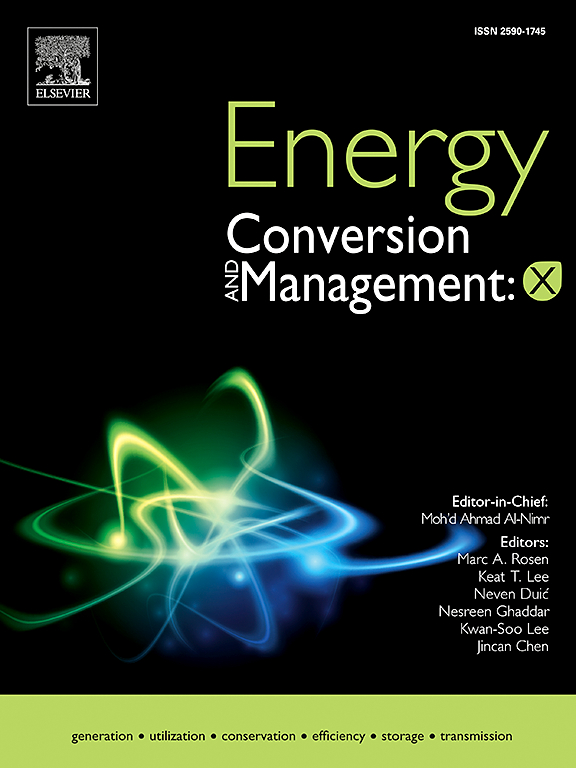IF 9.9
1区 工程技术
Q1 ENERGY & FUELS
引用次数: 0
摘要
合理利用光伏发电是中国实现碳减排的重要途径。然而,许多基于气候数据的物理预测方法并未充分考虑全球气候模型(GCMs)在不同地区的显著差异和数据偏差。为解决这一问题,本文提出了一种基于近地面气温和太阳辐射的新型光伏发电预测框架。此外,还提出了一种区域划分和周期划分的改进三角洲方法,通过与贝叶斯模型平均法(BMA)的耦合,显著降低了气候数据的模拟误差。光伏电池的转换效率和四种共享社会经济路径共同被纳入考虑范围,以实现高效的光伏发电潜力预测。对近六百万气候数据量进行了定量分析,证明了该方法的强大适用性。地表下沉短波辐射和近地面气温的相关系数分别增加了 11.44 % 和 2.07 %,均方根误差分别减少了 53.86 % 和 56.21 %。预测结果表明,在可持续发展路径下,2030-2059 年和 2060-2099 年中国更有利于光伏发电,光伏发电潜能均值可达 110.86 W m-2 和 168.51 W m-2,可实现碳减排 0.968 t m-2 yr-1 和 1.472 t m-2 yr-1。如果中国的光伏装机容量达到 15,000 平方公里,光伏电池转换效率提高到 50%,则 2044-2059 年期间可实现碳中和。这项研究为中国高效光伏发电预测和能源政策制定提供了理论依据,同时也为其他有类似需求的国家提供了方法论支持。本文章由计算机程序翻译,如有差异,请以英文原文为准。

Efficient photovoltaic power prediction to achieve carbon neutrality in China
Rational utilization of photovoltaic (PV) power generation is a key pathway for China to achieve carbon reduction. However, many physics-based prediction methods using climate data have not fully accounted for the significant discrepancies and data biases in Global Climate Models (GCMs) across different regions. To address this issue, a novel PV power prediction framework based on near-surface air temperature and solar radiation is proposed. A region-divided and period-segmented improved Delta method is also proposed to significantly reduce the simulation errors of climate data by coupling with Bayesian Model Averaging (BMA). The conversion efficiency of PV cell and four Sharing Socioeconomic Pathways are considered collaboratively for efficient PV power potential prediction. Nearly six million climate data volumes were quantitatively analyzed, demonstrating the strong applicability of this approach. The relevance coefficients for surface downwelling shortwave radiation and near-surface air temperature increased by 11.44 % and 2.07 %, while the root mean square errors decreased by 53.86 % and 56.21 %. The prediction results show that China is more favorable to PV power generation under the sustainable development path during 2030–2059 and 2060–2099, the average value of PV power potential can reach to 110.86 W m−2 and 168.51 W m−2, leading to carbon emission reductions of 0.968 t m−2 yr−1 and 1.472 t m−2 yr−1. If China’s installed PV capacity reaches 15,000 km2 and PV cell conversion efficiency rises to 50 %, carbon neutrality could be realized during 2044–2059. This study provides a theoretical basis for efficient PV power prediction and energy policy formulation in China, while also offering a methodological support for other countries with similar demand.
求助全文
通过发布文献求助,成功后即可免费获取论文全文。
去求助
来源期刊

Energy Conversion and Management
工程技术-力学
CiteScore
19.00
自引率
11.50%
发文量
1304
审稿时长
17 days
期刊介绍:
The journal Energy Conversion and Management provides a forum for publishing original contributions and comprehensive technical review articles of interdisciplinary and original research on all important energy topics.
The topics considered include energy generation, utilization, conversion, storage, transmission, conservation, management and sustainability. These topics typically involve various types of energy such as mechanical, thermal, nuclear, chemical, electromagnetic, magnetic and electric. These energy types cover all known energy resources, including renewable resources (e.g., solar, bio, hydro, wind, geothermal and ocean energy), fossil fuels and nuclear resources.
 求助内容:
求助内容: 应助结果提醒方式:
应助结果提醒方式:


